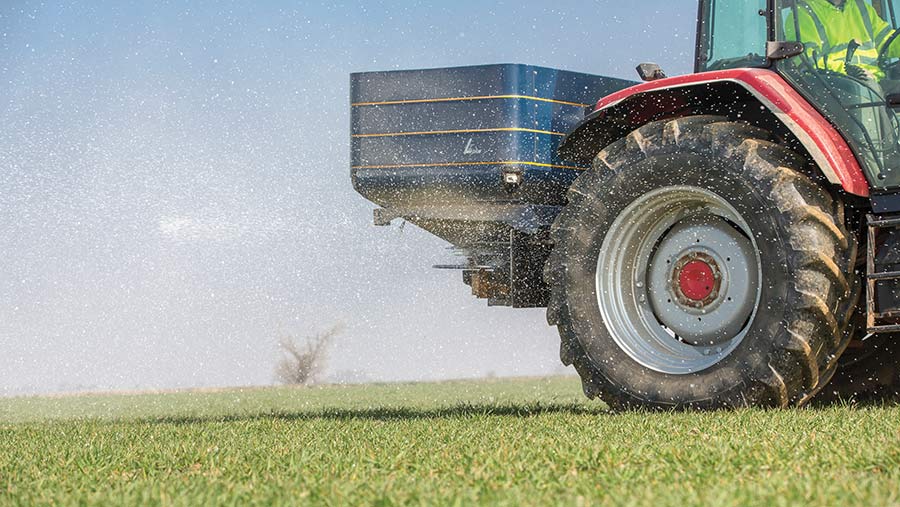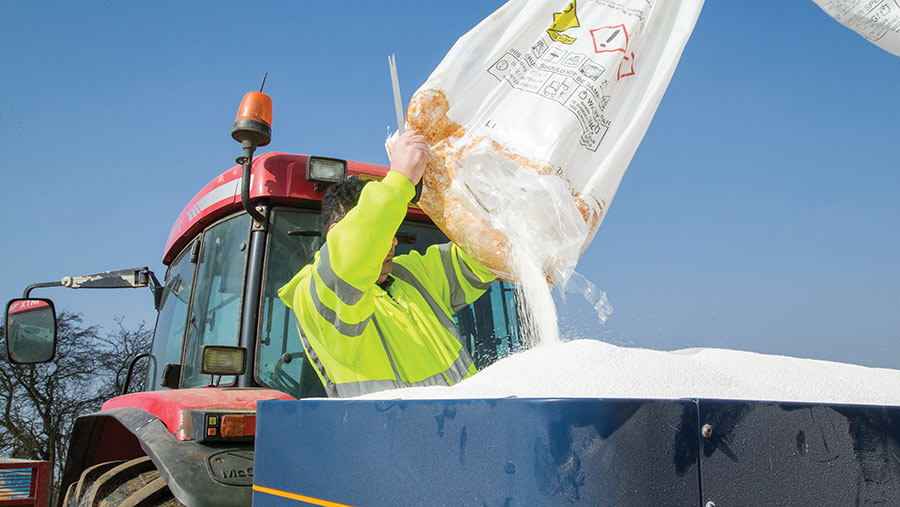Fertiliser market developments after disruption of 2022
 © GNP
© GNP As an island with just one domestic ammonium nitrate (AN) manufacturer, the UK is exposed, relying heavily on imports for crucial plant nutrients.
Gas had become the feedstock of choice in Europe and Russia’s move into eastern Ukraine in February 2022 severely disrupted what had been a relatively stable fertiliser market.
See also: Landscape recovery scheme round two – how it works
Russia produces about 30% of the world’s fertiliser requirements and while the UK banned vessels with Russian flags after the action began in February 2022, fertiliser was not a sanctioned product.
Urea from Russia continued to enter the UK in large quantities in 2022, much of it destined for industrial uses – for example, urea is used to make the diesel exhaust fluid AdBlue.
Problems with the logistics of Russian exports, in particular shipping, insurance and banking, presented too great a risk, say merchants.
First-quarter figures for this year show almost 39,000t of urea for all uses came from Russia, a fall of almost 60% compared with January to March 2022. Overall, UK urea imports fell 18% in January-March this year to 251,631t.
North Africa is an important source for all types of fertiliser for the UK.
Egypt continues to be the main urea supplier to the UK, and in 2022 was the origin of almost 540,000t of the 1.27m tonnes that was imported, again for many uses in addition to agriculture.
Poland and Lithuania remain the largest suppliers of imported AN to the UK, accounting for two-thirds of imports last year.
However, across Europe more widely and in many other countries, much AN manufacturing capacity was mothballed in 2022 as the level of gas prices made it unviable to operate.
Changes at CF
After closing its Ince plant in Cheshire in June last year, the UK’s only AN manufacturer, CF Fertilisers UK, announced a move to import rather than manufacture ammonia for AN production at its remaining site at Billingham.
This has made it more flexible and stable, says Jo Gilbertson, head of fertiliser at the trade body Agricultural Industries Confederation (AIC).
“To run a plant like that to make ammonia, any manufacturer would need to buy several months’ worth of gas in advance and, with prices as volatile as they were, that’s a big risk,” he says.
Gas prices, the feedstock for AN and urea manufacture, have largely been on a falling trend since the spike of more than 700p/therm in August 2022.
On Tuesday 27 June, the International Commodities Exchange (ICE) London August 2023 contract stood at 81p/therm, while November 2023 was at 126p/therm.
While urea is the most used nitrogen fertiliser globally, AN remains the choice in the UK, accounting for more than half of the nitrogen used (see “UK N use by type of product and share”).

© GNP
Urea use in the UK had been falling until the Russian action in Ukraine, but its ready availability and competitive price mean it is now growing, as is that of urea ammonium nitrate.
For the trade, the ready availability of urea is enhanced by its ease of handling.
Unlike AN, it is not covered by the Control of Major Accident Hazards (Comah) regulations, so it can be stored in large quantities and those transporting it do not need a dangerous goods driver (ADR) qualification.
While agricultural demand for nitrogen overall is more or less stable, demand for compounds is significantly lower than it was, as a result of many taking phosphorus and potassium holidays and more recently by a significant drop in demand from the grassland sector.
“This matter is certainly not helped by the phased withdrawal of government support for farming,” says Jo.
“If you take high-performing dairy demand for fertiliser out of the mix and the top end of beef producers, the grassland sector is more exposed to having to buy at the time of use and paying spot prices.”
A land use strategy from the government, building in food sustainability, defining what land is for and how we are going to feed ourselves, is essential for building confidence, he says.
Within the fertiliser supply-and-demand outlook mix is the unknown of China, in terms of the rate of its economic growth over the next few years, its desire to see its citizens eating more animal protein and whether it will be an importer or an exporter of plant nutrients.
Ammonia
A key Russian ammonia pipeline was attacked and damaged on 5 June.
This runs for about 1,500 miles from Togliatti in Russia, through Kharkiv in Ukraine and to the Black Sea port of Odesa.
It can carry more than 2m tonnes of ammonia a year and was closed in 2022.
There were plans to restart its operation, linked to a renewal of the Black Sea Grain deal.
Elsewhere, there is significant investment going into ammonia production capacity globally, including in the US and other countries where there is access to cheap gas.
A portion of the US government’s large green energy investment is going into ammonia, which is a more energy-dense product and more efficient to transport than liquid gas.
Yara and CF are developing green ammonia, made using renewable energy sources, to improve the sustainability of food production and other uses of ammonia (see “Down the line – product and market developments”).
Down the line – product and market developments
Urea emissions
Fertiliser use and emissions are coming under increasing scrutiny.
The Agricultural Industries Confederation’s Jo Gilbertson is concerned that unless more effort is made to use agents such as inhibitors to curb ammonia emissions from urea, Defra will impose restrictions rather than allowing industry and farming to rely on voluntary measures due to take effect from 1 April 2024.
“If we want to keep urea on the agenda, farmers need to get seriously behind this. Defra has signalled that otherwise there will be legislation.”
At present, the lower per-kilo cost of urea nitrogen compared with the per-kilo cost of AN nitrogen outweighs the £40-£50/t inhibitor cost, keeping urea competitive with AN.
Nutrient neutrality
Nutrient neutrality requirements are part of planning rules and will see an increasing area of land taken up to provide phosphate (and in some places nitrogen) mitigation when developments, including many farm buildings, are built out.
Cadmium
Cadmium levels in phosphates from some sources are an issue. Product from Morocco has higher levels than that from Belarus, which together with Russia supplied about 40% of the world’s phosphates prior to the Russian action in Ukraine.
The EU regulates cadmium levels in fertiliser and rules on heavy metals in fertilisers are also expected in the UK.
New markets for ammonia
Ammonia is increasingly being viewed as a clean fuel, as it does not emit carbon dioxide when burned.
This is leading to its promotion as an alternative shipping fuel, which could divert supply away from agriculture.
Also, ammonia can be decomposed (known as cracking) to produce hydrogen for fuel, along with nitrogen, again creating new markets for ammonia.
Efforts to produce ammonia with renewable energy will result in zero or minimal greenhouse gas emissions from the product, increasing its attractiveness.
Nitrogen fertilisers
European production of urea is back to about 70% capacity compared with just 30% shortly after the war started, says Deepika Thapliyal, deputy managing editor, fertilisers at commodity intelligence firm ICIS.
“In 2022, buyers imported a significant quantity of urea at high prices and were then stuck with expensive inventories as the market started to come off highs, with production returning to usual levels in Europe.
Buyers are now cautious and only buying hand to mouth, as they are worried prices will keep falling in 2023,” says Deepika.
The UK is almost entirely dependent on imports for its phosphate fertilisers, as are many other European countries.
For the UK, these come mainly from Morocco, although Russia and China have also featured.
Potash
Muriate of potash [MOP] is readily available globally in a bearish market, despite widespread upheaval felt across the world’s wider MOP market over the past two years from sanctions placed on Belarus and Russia, the world’s second- and third-largest MOP producers, whose exports have fallen sharply, says ICIS.
The UK’s import levels have changed little and are at 300,000-425,000t annually, with the majority coming from Israel, Spain and Germany.
UK N use by types of product and share |
||
|
Product |
Share of total N in 2021-22 |
Change in share 2017-22 |
|
Ammonium nitrate |
50% |
-13% |
|
Urea |
11% |
-6% |
|
Urea AN solutions |
28% |
+15% |
|
Calcium ammonium nitrate |
10% |
+6% |
|
Source: AIC |
||
